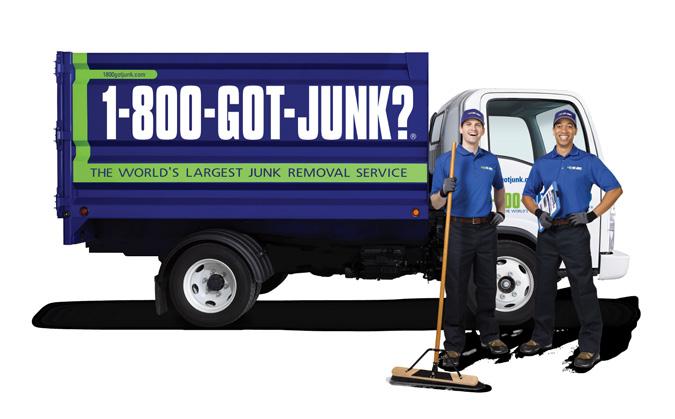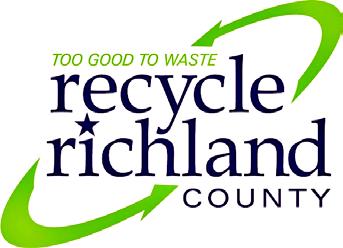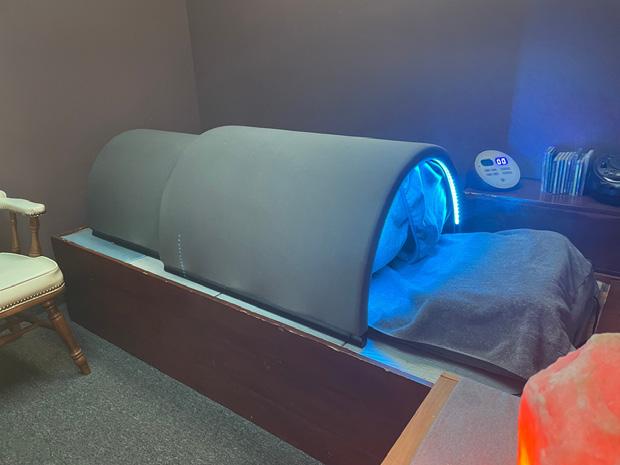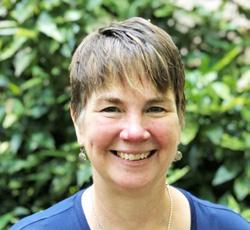PEOPLE. PLANET. PURPOSE.

















Don't miss interviews and lifestyle tips for reducing stress.

Scan the QR code to JOIN US LIVE ONL INE as these top women in wellness share their expert insights for reducing stress and achieving WELLthier Living!





Natural Awakenings is a network of natural lifestyle magazine publishers empowering local communities with knowledge, resources and connections to lead healthier lives on a healthy planet.



To advertise with Natural Awakenings, please contact us at 803-309-2101 or email ColaPublisher@ NaturalAwakenings.com. Deadline for ads: the 12th of the month.
Email articles, news items and ideas to ColaPublisher@ NaturalAwakenings.com. Deadline for editorial: the 10th of the month.
Submit Calendar Events at ColumbiaNaturalAwakenings. com or email to ColaPublisher@NaturalAwakenings.com Deadline for calendar: the 10th of the month.

Advertise your products or services in multiple markets! Natural Awakenings Publishing Corp. is a growing franchised family of locally owned magazines serving communities since 1994. To place your ad in other markets call 239-206-2000. For franchising opportunities call 239206-2000 or email Natural Awakenings@KnoWEwell.com.
PUBLISHER Annette Carter Briggs
EDITOR Sara Gurgen
DESIGN & PRODUCTION
CONTRIBUTING WRITERS
SALES & MARKETING
Kristina Parella
Billy Briggs
Odell Williams
Kristi Antley
Annette Carter Briggs
WEBSITE Kristina Parella
Billy Briggs
CONTACT US
PO Box # 2812 Columbia, SC 29202 Email
ColaPublisher@NaturalAwakenings.com

Annette Briggs Ph: 803-309-2101 Website ColumbiaNaturalAwakenings.com
SUBSCRIPTIONS
Subscriptions are available by sending $24 (for 12 issues) to the above address.
NATIONAL TEAM
CEO Kimberly B. Whittle
COO/Franchise Sales

Joe Dunne
National Editor Sandra Yeyati
Editor Brooke Goode
Copy Editor/Proofreader
Design & Production
National Advertising

Oneof the things that I love to do in the morning is put on a fresh pot of coffee, pour me a hot cup of “liquid motivation,” sit down and sip away as I gaze out of my bay windows in front of the bistro table. The view is gorgeous and my morning therapy as I watch the squirrels, birds, hawks (that chase everything away … ugh!), colorful insects and a host of other visiting friends from the natural world—all of which color my morning and jumpstart my day. The gifts and treasures of God’s Earth surround us, all waiting to be explored, experienced and appreciated; however, the sad and very sobering reality is that the masterpiece of creation (with all its beauty and wonder) is not only ignored, but even worse, neglected and abused more times than I care to mention. I see it, you see it, we live it every day!
From litter carelessly strewn around to water pollution that threatens our critical water sources, our planet is under siege by the very ones that need it most—humans! Ponder this thought: “Sooner or later, we will have to recognize that the Earth has rights, too, to live without pollution. What mankind must know is that human beings cannot live without the Earth, but the planet can live without humans.” What words of stinging truth and wisdom from Bolivian politician and activist Evo Morales.
Let’s dig a little deeper into this critical topic and talk water and oceans. According to research, in numerous developing countries, 90 percent of wastewater and 70 percent of industrial waste is discharged without treatment or processing. Moreover, land-based sources account for 80 percent of marine pollution. Think about this: Annually, 6.5 million tons of litter finds its way into our oceans, and 50 percent of that will unfortunately drift for hundreds of years before degrading. Nearly 100,000 marine mammals and turtles worldwide are killed annually by plastic litter. According to estimates, 267 marine species have been reported entangled in or as having ingested marine debris. In America, approximately 40 percent of our lakes are too polluted for fishing, aquatic life, or swimming!
Melanie Rankin
Gabrielle W-Perillo
Lisa Doyle-Mitchell

CONTACT US
Natural Awakenings Publishing Corporation
350 Main Street, Suite 9B
Bedminster, NJ 07921
Ph: 239-206-2000

NaturalAwakenings@KnoWEwell.com
© 2023 by Natural Awakenings. All rights reserved. Although some parts of this publication may be reproduced and reprinted, we require that prior permission be obtained in writing.
Natural Awakenings is a free publication distributed locally and is supported by our advertisers. Please call to find a location near you or if you would like copies placed at your business.
We do not necessarily endorse the views expressed in the articles and advertisements, nor are we responsible for the products and services advertised. Check with a healthcare professional regarding the appropriate use of any treatment.
Yes, the Earth has rights too, and we need to recognize that by becoming better stewards of this priceless jewel seriously threatened by neglect, abuse and apathy. Are you ready for some good news? Although still a serious problem, litter and littering have decreased in the past 40 years. In a recent litter characterization study, visible roadside litter was found to have decreased by about 61 percent since 1968—largely due to focused litter campaigns and mobilization efforts by such organizations as Keep America Beautiful. We can and should do more to protect our planet. We, in fact, must … the facts are clear. You and I must take a more active and vigilant position as Earth’s caretakers by living more sustainable lifestyles, marked by smart, conscious decisions and choices that reflect our care and concern for this planet we call home.
Now, time for some kudos! To organizations such as Keep the Midlands Beautiful, PalmettoPride, Sonoco Recycling, local city and county offices, and many others, I say with all sincerity “thank you” for your hard work and invaluable contributions to make and keep South Carolina one of the most beautiful states in the country!

Nestled in beautiful Irmo, Foot Savi takes a unique, home-like approach to bracing, orthotics and prosthetics. The innovative foot care provider pays particular attention to individual fit—in fact, the company’s motto is “Fit for Health.” From European comfort shoes to American-made athletic wear, Foot Savi offers professional expertise fashioned for optimal care in a living room-style setting. The popular shoe provider carries high-quality top line brands, such as Birkenstock, Finn Comfort, Munro, Joya, SAS, New Balance and Brooks.
Foot Savi also carries a variety of bracing products, as well as therapeutic shoes for diabetics. Its compression lab offers custom fit and edema therapies and its custom orthotics lab specializes in custom orthotics for specific foot issues, emphasizing fast turnaround times.

Foot Savi’s owner and chief pedorthist is a certified medical equipment and supplies specialist with more than 30 years of experience. Its beautiful med spa focuses on unsightly nails, calluses, ingrown toe nails and debridement, along with relaxing reflexology and stretching for achy feet. Conveniently located in the Murraywood Centre for more than 20 years, Midlands area residents are welcome to come and see Columbia’s best kept secret in total foot care and footwear.
Location: 7001 St. Andrews Rd., Ste. A, in Columbia. For more information, visit FootSavi. com or SolutionsOrthoCare.com (for diabetic shoes). See ad, page 11.

Every day is Earth Day, so don’t limit your enthusiasm to just one day. Explore environmental activities 365 days a year by subscribing to the city of Columbia’s Climate Protection Action Campaign’s monthly e-newsletter. Speaking Sustainability features sustainability updates, event listings, green links and more. The distribution list isn’t shared and one can unsubscribe at any time.
To subscribe, visit bit.ly/3liY1ui or email Sustainability Facilitator Mary Pat Baldauf at Mary.Baldauf@ColumbiaSC.Gov.
Eye Love Me is an innovative brand provider that caters to the mind, body and spirit/soul.

Eye Love Me’s products help to bring one closer to one’s higher self while educating and providing insight on the importance of self-love. Many of Eye Love Me’s popular and eclectic product selections are organic and handmade. They include sage bundles, altar pieces, bath and body products, moon and fairy mirrors, herbal smoke blends and much more. Other great items include keepsake boxes, “fixed” candles, body butters, lip scrubs, jewelry and much more.
“We aspire to aid in healing internally and externally, so that when we elevate in frequency we have a superior "inner-standing" on how to restore ourselves in its entirety. It starts with you. We desire everyone to recognize and acknowledge their own individual purpose, so that they open themselves to receive all that brings light into their realities,” states owner and operator Jenycez Woodard.
For more information, visit EyeLoveMe. BigCartel.com.


Original Origins Health and Wellness is pleased to announce its Women’s Self-Care Retreat, scheduled from Friday, August 4, through Monday, August 7, in Sevierville/ Pigeon Forge, Tennessee. The mission and purpose of the retreat is to provide the ideal environment for honored guests to reconnect and rejuvenate the mind, body and spirit. The retreat experience will feature a variety of speakers, including a licensed mental health therapist, a motivational speaker, and a licensed massage therapist. Other activities include healthy cooking demonstrations and live entertainment. Breakfast, lunch, snacks and lodging are all included in the retreat cost. In addition, the cost is based on double occupancy. Space is limited, so those interested are encouraged to register early. The total cost of the retreat is $747, and a deposit of $100 is required by Saturday, April 15. As a note, the retreat space does not offer handicap accessibility. Come and enjoy a life-changing experience.
For more information, including the retreat location, contact Ms. Tracy at 833-678-7229 or OriginalOriginsHW@gmail.com. Also visit OriginalOriginsHW.com. See ad, page 7.
On Thursday, April 6, from 7 to 8:30 p.m., the Irmo Chapin Recreation Commission (ICRC) is hosting its Flashlight Egg Hunt at Melvin Park, located at 370-A Eptings Camp Road, in Chapin. Held rain or shine, kids (1 to 12 years of age) will be hunting eggs in the dark, so flashlights and Easter baskets will be needed. Space is limited, so those interested are encouraged to preregister. This year, there will be more than 10,000 eggs to find!
Cost: $2 per child in advance; $5 per child event day. For more information, call 803-3458113 or visit icrc.net/event/flashlight-egg-hunt-0.


Because you can; it is your legal right.
It’s a common belief that people are no longer able to care for their own deceased and have to hire a funeral professional to provide care. That is not the case. Please take a moment to explore how Eternal Planning LLC can help.
The Earth is being affected by how funerals are conducted today. It is estimated that as much as 800,000 gallons of formaldehyde are placed in the Earth’s soil each year due to conventional burials. In addition to that, nearly 115 million tons of casket steel, 2.3 billion tons of concrete from burial vaults and casket wood (equivalent to 4 million acres of forest annually) unfortunately find their way into the Earth’s soil. Cremation is not much different. In North America, the cremation process consumes a tremendous amount of fossil fuel.
Eternal Planning LLC’s mission is to inform families that there are alternatives to what is considered traditional funeral arrangements and to make sure that families know how to conduct home funerals for their loved ones properly and legally, by lending ideas, demonstrating techniques, advising, sharing knowledge and bearing witness. A home funeral is a family-led, family-directed, eco-conscious, cost-conscious and meaningful way to care for loved ones that have transitioned.
Eternal Planning LLC promotes environmentally sound and caring practices, informs and empowers families and communities on how to properly care for their loved ones, and educates the general public with regard to the innate rights of families.
For more information, call 803-8467993 or email Cassandra@EternalPlanningSC.com. Also visit EternalPlanningSC.com. See ad, page 22.

S ometimes those of us on a spiritual journey of growth hit a rough patch that I’ve come to call a “spiritual funk.” Maybe you have had such an experience? Everything is going along great, firing on all spiritual cylinders, so to speak, and then all of a sudden … we hit a wall. It’s as if all of our spiritual principles seemingly fly out the window! What is going on?!?
Well, if you have had such an experience, then you are not alone. In fact, I personally don’t know of anyone that has not encountered spiritual funk. The good news is that it won’t last forever. And, there is more good news— trials and challenges that produce spiritual funk tend to make one stronger. I have found that shaking “the funk” is always a matter of letting something go—some idea I am hanging onto, or maybe an unfinished piece of forgiveness work whose time has come. In addition, it can take time to know how to move forward. It seems like “sitting in it” for a while is part of the process … and that’s okay.
Here is what I suggest that you do if you find yourself in a spiritual funk. First, don’t lose hope. It will pass. Second, cut yourself some slack and allow yourself to relax. Kick back and watch a show or read a book. Eat chocolate if you’d like. Or, as a sage once said, “Don’t just do something. Sit there!” Third, spend some extra time in prayer and/or meditation each day. Keep it simple. And finally, when you see a way forward, go for it. Trust your inner spiritual guide. You will intuitively know what to do.
If you want to find others that live this way every day, I invite you to join us Sunday mornings at 11 a.m. at Unity of Columbia to celebrate the power of Spirit in our lives through meditation, music and message.


Location: 1801 Legrand Rd., Columbia. For more information, visit UnityColumbia.org. See ad, page 25.




OnSaturday, April 22, from 8 a.m. to noon, Richland County Solid Waste and Recycling is hosting its Richland Recycles Day at the Columbia Place Mall, located at 7201 Two Notch Road. For Richland County residents only, the list of acceptable items includes scrap metal, paint (limit 8 gallons per car), tires (limit eight per car), household hazardous waste (chemicals, cleaners, pesticides) and more. This is a drive through, drop-off event for non-businesses only. As a note, commercial materials will not be accepted.


For more information, call 803-576-3588 or visit RichlandCountySC.gov.


On Saturday, April 15, from 10 a.m. to 2 p.m., the McGregor Presbyterian Church is hosting its Community Earth Day Celebration at the McGregor Learning Garden, located at 6505 St. Andrews Road, in Columbia. Taking place rain or shine and open to the entire family, the celebration provides a wonderfully sustainable opportunity for Midlands area residents to buy local honey, Carolina wren houses, and other fun eco-friendly items. Other event highlights include a community plant swap and food purchases provided by the C.R. Burton Food Truck.

Attendees will also have the opportunity to support two great organizations and their important causes: the Carolina Wildlife Center, which rehabilitates injured and orphaned animals, and Keep the Midlands Beautiful, which is hosting its annual shoe collection drive. Participants can bring their gently used shoes to help families in need.
For more information, contact David Jenkins at DJenkins880@gmail.com. Also visit mcgpres.org.

On Friday, April 7, from 6 to 6:30 p.m., the Irmo Chapin Recreation Commission (ICRC) is hosting its EGG-cessible Egg Hunt at Saluda Shoals Park East, located at 6071 St. Andrews Road, in Columbia. Free and open to people of all ages with mental and/or physical disabilities, the accessible egg hunt will be held at Leo's Landing Inclusive Playground. Participants will need to bring their own basket to collect eggs. Preregistration is required.

For more information, call 803-772-1228 or visit icrc.net/event/ egg-cessible-egg-hunt.
It’s time to hunt for eggs! The Irmo Chapin Recreation Commission (ICRC) is hosting its annual Egg Hunt on Saturday, April 8, from 11 a.m. to 1 p.m. at the fields of Saluda Shoals Park East, located at 6071 St. Andrews Road, in Columbia. Children will be divided by age and gathered in groups on different soccer fields. Attendees are asked to bring baskets for egg collection. In addition, food trucks will be on-site and available for food purchases. Space is limited, so online preregistration is required by Friday, April 7, or until full.
Cost: $5 per child. To register or for more information, call 803-772-1228 or visit icrc.net/event/saluda-shoalspark-egg-hunt.

The Living Wright Foundation invites the public to its celebration of spring and the arrival of beehives at the community farm at Senate’s End on Thursday, May 11, from 6 to 9 p.m. Celebration highlights include live music, a silent auction, signature cocktails inspired by what’s blooming in the garden, and a dinner menu presented by Chef John Chiles. Guests can enjoy a farm tour at 5 p.m. prior to the night’s activities.
Living Wright’s mission is to combat food insecurities in the Midlands by educating the local community and by providing them with regenerative farming and gardening techniques. The Living Wright Foundation is a nonprofit organization founded by Robert Wright Percival and his father, Dupre Percival. Beginning in 2015, Living Wright’s founders set out to address local food insecurities through partnerships with local organizations, to include Harvest Hope Food Bank, Richland County First Steps, and Zion Lutheran Church. Together, they have provided 426,000 meals to local children, seniors and the homeless population to date. “Our potential and capacity is to provide upwards of 20,000 pounds of fresh food annually to more than 65,000 residents experiencing food insecurities. Local urban agriculture affords the development of a variety of environmental, economic and social benefits, such as transportation cost reduction, curb runoff mitigation associated with heavy rainfall, pollinator attraction, and air quality improvement,” states Dupre Percival.
Cost: $50 in advance; $65 at door. Location: 300 Senate St., in Columbia. To RSVP and/or to purchase tickets, email Info@LivingWrightFoundation.org. See ad, page 39.

It’s a toast! On Friday, April 28, from 6 to 9 p.m., the Gills Creek, Rocky Branch and Smith Branch watershed associations will host their very popular Wine for Water Earth Day celebration to commemorate their unified vision and pledge to preserve the streams and rivers in and around the greater Midlands area. Hosted at the Hall at Senate’s End, the proceeds from the Wine for Water event will help support the efforts of the watershed associations, environmental nonprofits dedicated to restoring the Midlands’ watersheds through education, grassroots action, and public and private partnerships. Attendees will enjoy a variety of wines paired with food from local restaurants and caterers. Other event highlights include live entertainment, local beer selections, a silent auction and wine bottle bingo. Bring a friend. The Gills Creek Watershed Association is a Columbia-based environmental nonprofit dedicated to protecting the Gills Creek Watershed through advocacy, restoration, conservation and education.
Cost: Ticket prices vary (call or see website for details). Location: 300 Senate St., Columbia. For more information, call 803-727-8326 or 803-470-4302. Also visit GillsCreekWatershed.org.

K eep the Midlands Beautiful (KMB) started hosting its annual shoe recycling drive to support local area conservation and sustainability while helping families from developing countries in need. Taking place through Wednesday, May 31, the shoes collected through this effort would otherwise find their way to local landfills. KMB encourages individuals, businesses, churches, schools and other organizations across the Midlands to help them collect gently worn and new shoes of any style and size (including kids' shoes, athletic shoes, slippers, work boots, etc.). Collected shoes can be dropped off at KMB’s office, located at 1305 Augusta Highway, in West Columbia. Participants are asked to place shoes in the roll cart labeled for shoe collection on the covered front porch. In 2022, KMB and its community partners collected 6,600 pairs of shoes!
For more information, call 803-733-1139, email Info@KeepTheMidlandsBeautiful.org or visit KeepTheMidlandsBeautiful.com.


Saturday, April 29, from 9 a.m. to noon, Keep the Midlands Beautiful (KMB) is hosting its Spotless Service Saturday project at Rawl’s Creek, in the town of Irmo. Service volunteers will meet at the Irmo Town Hall, located at 7300 Woodrow Street, and break up into groups to address litter along various sections of the waterway. Check-in will be at 8:30 a.m. Participants will attend a short safety briefing and then will be provided project supplies. KMB will provide all supplies, water and a thank you gift. Preregistration is required.
For more information, call 803-733-1139 or visit KeepTheMidlandsBeautiful.org.

OnTheSouth Carolina Ag + Art Tour is a free, self-guided tour of farms and markets featuring local artisans at every stop. The S.C. Ag + Art Tour will include farms and artisans located in 11 counties, with different counties participating each weekend in May and June on Saturdays from 10 a.m. to 4 p.m. and Sundays from 1 to 5 p.m. Now in its 12th year, this popular farm and art tour is a great way for residents to learn about where their local food, fiber and forest products come from and to meet local artisans.
Tour stops include farms, farmers markets and other agriculture- and art-related establishments with artisans at each location. Artisans on the tour range from weavers, painters, musicians, storytellers, metalworkers and craftsmen to poets and live musical performances. Some farms will offer value-added products, such as jarred and canned foods, honey, baked goods or even farm-fresh meals.
For more information about the tour, including a list of participating sites, dates and artisans, visit AgAndArtTour.com. See ad, page 9.

 by Sandra Yeyati
by Sandra Yeyati
This year’s Earth Day theme— Invest in Our Planet—reminds us that it is not enough to merely celebrate our ancestral home for one day. We are called upon to dedicate our time, money and talents year-round to ensure a sustaining and just world for generations to come. The motto also calls attention to the economic realities and opportunities of the climate crisis. It is no wonder that EarthDay.org , the global organizer of this annual event, decided to keep the same theme as last year, thus underscoring a continuing need to bring global economies together in harmony with the environment.
“In 2023, we must come together again in partnership for the planet. Businesses, governments and civil society are equally responsible for taking action against the climate crisis and lighting the spark to accelerate change towards a green, prosperous and equitable future. We must join together in our fight for the green revolution, and for the health of future generations. The time is now to invest in our planet,” advises EarthDay.org President Kathleen Rogers.
Surmounting the climate crisis is within reach if we all take action. The time is right for innovators to bring planet-saving ideas to market, and for consumers to stop supporting
brands that are socially and environmentally irresponsible—instead, spending money with businesses that take the Earth’s future seriously.
In the voting booth, citizens have the power to elect leaders that will help build a green economy through regulations, incentives and partnerships with the private sector. We can press our congressional representatives to support clean energy jobs and move away from the doomed fossil fuel economy.
There are many ways to make a difference in our daily lives, too. We can eat sustainable foods, pick up trash while on a run, participate in beach cleanups, reduce our use of plastic, write our representative, switch to solar power, take reusable bags to the grocery store, drive an electric vehicle, compost, go pesticide-free, plant a pollinator garden, support local farmers, eat less meat, purchase secondhand clothing, use environmentally friendly cleaning products, turn off lights when not in use, take shorter showers and so much more. Learn about all of the ways to make a difference at EarthDay.org.
This year, join one of the empowering events here in the Columbia area and meet planet-loving people that are ready to push up their sleeves, vote with their pocketbooks and dedicate their time to a healthy, equitable and prosperous future on Earth.
Subscribe to Columbia’s Speaking Sustainability E-Newsletter

Every day is Earth Day, so don’t limit your enthusiasm to just one day. Explore environmental activities 365 days a year by subscribing to the city of Columbia’s Climate Protection Action Campaign’s monthly e-newsletter. Speaking Sustainability features sustainability updates, event listings, green links and more. The distribution list isn’t shared and one can unsubscribe at any time.
To subscribe, visit bit.ly/3liY1ui or email Mary.Baldauf@ColumbiaSC.Gov.
On Saturday, April 22, from 8 a.m. to noon, Richland County Solid Waste and Recycling is hosting its Richland Recycles Day at the Columbia Place Mall, located at 7201 Two Notch Road. For Richland County residents only, the list of acceptable items includes scrap metal, paint (limit 8 gallons per car), tires (limit eight per car), household hazardous waste (chemicals, cleaners, pesticides) and more. This is a drive through, drop-off event for non-businesses only. As a note, commercial materials will not be accepted.
For more information, call 803-5763588 or visit RichlandCountySC.gov.
A Community Earth Day Celebration will take place on Saturday, April 15, from 10 a.m. to 2 p.m., at the McGregor Learning Garden, located at 6505 St. Andrews Road, in Columbia. There will be a plant swap, a Keep the Midlands Beautiful shoe drive, local honey, Carolina wren houses, and other eco-friendly items to purchase. In addition, there will be a food truck on-site for food purchases.
Two Londonbased roboticists, Mirko Kovac and Robert StuartSmith, have developed new technology that mimics the way bees work together to build a structure. They used two free-flying drones to build a human-sized tower. The “build drone” carried expanding foam and sprayed it in slow, steady circles to form layers, while the “scan drone” surveyed the structure and identified spots where the last layer was either too thin or too thick, and it then created a plan for the build drone to even things out on the next pass to keep the structure straight and sturdy.
In a second demonstration of the technology, the drones made a cylinder the size of a large round cake using a cement-like material. The duo exhibited a great deal of precision in stacking the material to within millimeters.
The team plans to take the drones outdoors to deal with the elements and add to the complexity of the objectives and number of drones involved. If the technology can be perfected, these collaborative construction drones could be used in places where it is difficult for humans and heavy machinery to reach, like the tops of buildings, remote pipelines and disaster areas.

A Swedish battery manufacturer, Northvolt, in partnership with Stora Enso, one of the largest private forest owners in the world, has developed a battery for electric vehicles (EV) with an anode made of sustainably raised and harvested wood instead of graphite, paving the way for battery production from a renewable source.

The partners figured out a way to extract lignin, a carbon-rich natural binder that comprises up to 30 percent of many trees, and turn it into a material they call Lignode. According to Stora Enso, by replacing graphite or copper anodes with Lignode, lithium-ion batteries will offer faster charging and discharging, higher cycling stability and more efficient performance in low temperature.
More than 50 percent of the EV’s carbon footprint comes from the manufacture of its battery—both in sourcing raw materials and producing the component. Mining graphite is an expensive and labor-intensive process that requires considerable resources that come from parts of the world where workers’ rights are inadequately protected. While Northvolt’s battery is not on the market yet, this development, along with others like solid-state batteries, may help to reduce the carbon footprint of EVs.

Rapid ocean warming and other effects caused by climate change have stressed and degraded corals around the globe, and scientists have been studying ways to rebuild, manage and conserve these vital ecosystems. A new Australian study published in Journal of Applied Ecology tested whether playing certain sounds underwater at reef restoration sites could boost the recruitment of oysters and enhance their habitat-building activities. Australia’s flat oyster is a key reef-building organism targeted for restoration efforts.
Previous studies had shown that the sound of healthy reefs differs from that of damaged reefs. Using inexpensive marine speakers, the researchers reproduced the sound of a healthy reef at four sites across two of the largest oyster reef restorations in Australia and compared the results to areas that did not receive this soundscape enrichment. The sonically enhanced areas resulted in the presence of more and larger oysters that formed more three-dimensional habitats atop the reef restorations. The scientists propose that the use of marine soundscapes during early stages of new reef restoration projects could reduce the cost of habitat recovery.

A new study published in Molecular Psychiatry has shown that eating more fermented foods and fiber daily for just four weeks significantly lowered perceived stress levels. Forty-five participants with relatively low-fiber diets were split into two groups.
One group met with a dietitian that recommended a psychobiotic diet, which included six to eight daily servings of fruits and vegetables high in prebiotic fibers, such as onions, leeks, cabbage, apples, bananas and oats; five to eight daily servings of grains; three to four servings of legumes per week; and two to three daily servings of fermented foods like sauerkraut, kefir and kombucha. The control group received only general dietary advice based on the healthy eating food pyramid.
The group following the psychobiotic diet reported feeling less stressed compared with those in the control group. Moreover, significant changes in the level of certain key chemicals produced by gut microbes were found in these participants. Some of these chemicals have been linked to improved mental health, which could explain why the participants reported feeling less stressed. The quality of sleep improved in both groups, but those on the psychobiotic diet reported greater sleep improvements.
Pomegranate fruit has been widely used in traditional medicine, and a new, randomized, double-blind, placebo-controlled study published in the Journal of Clinical Medicine looked at the effects of taking pomegranate extract for a period of four weeks on different aspects of skin and gut health. Using facial imaging, researchers found the group that received the pomegranate extract had significant reductions in wrinkle severity and a decrease in the rate of forehead sebum excretion. They also found beneficial effects to the gut-skin axis, noting that participants in the pomegranate extract group had a higher abundance of Eggerthellaceae in the gut with accompanying wrinkle reduction. The scientists concluded that the skin benefits from pomegranate extract may be due to the potent antioxidant and anti-inflammatory properties of phytochemicals, as pomegranate contains more than 100 bioactive constituents.

Researchers in the UK compared the effect that different types of daily movement had on overall cognition, memory and executive function. Their study, published in the Journal of Epidemiology and Community Health, reported that replacing sitting, sleeping or gentle movement with less than 10 minutes of moderate to vigorous activity (brisk walking, bicycling, running up and down stairs, aerobic dancing, jogging, running or swimming) can protect the brain and improve working memory and executive processes like planning and organization. The intensity of the exercise matters, and study participants that engaged in light physical activity, rather than more vigorous activity, saw declines in cognitive performance. However, light activity is still more beneficial than sitting, the scientists found.
The data for these findings was taken from the 1970 British Cohort Study, an ongoing survey that tracks the health of a group of UK-born adults. The group of nearly 4,500 participants consented, at age 46, to wear an activity tracker and complete verbal memory and executive functioning tests, and they were followed from 2016 to 2018.

There are many ways to be environmentally responsible when shopping for food. Here are a few tips.
Bring Reusable Shopping Bags
Americans use approximately 100 billion single-use plastic bags each year, which accumulate in landfills and waterways and never truly decompose. Some states have banned disposable bags, but many still permit them. Come prepared to the grocery store with reusable bags to reduce the use of single-use plastics.
Shop the Perimeter
Food packaging and containers make up 23 percent of landfill waste. Shop around the perimeter of the store as much as possible to find the freshest, healthiest foods with the least amount of packaging, such as produce, bulk items, dairy, fresh fish and meat. Bulk items like nuts, dry beans, coffee, tea and grains can be purchased in exactly the amount needed with no packaging.
Plan Ahead
The average American wastes about 21 percent of the food they buy, which equates to about $1,800 a year. To avoid overbuying and shrink the carbon footprint of multiple shopping trips, plan meals a week (or month) ahead and come with a shopping list organized by the sections or aisles of the store.

Shop Local and In Season
Local produce has a drastically smaller carbon footprint than fruits and vegetables that must travel long distanc-
es by truck, airplane or ship. Buying local, in-season produce reduces waste because the produce is fresher when purchased and will not spoil as quickly at home. If the family’s diet includes meats, choose pasture-raised, grass-fed products from farmers that practice regenerative organic agriculture, which improves the quality of the land and maintains local ecosystems.
Choose foods that were produced with the environment in mind by looking for the following labels, seals and certifications:
n USDA Organic
n Biodynamic (BDA) for food produced without chemical pesticides or herbicides, using organic, non-GMO seeds
n Non-GMO Project Verified for foods that were not genetically engineered
n FAIRTRADE Mark and Fair Trade Certified for food producers committed to reasonable wages and the safe, fair treatment of workers
n Climate Neutral Certified for food manufacturers committed to reducing their greenhouse gas emissions
n Safe Catch for sustainably caught fish
n Aquaculture Stewardship Council (ASC) and Best Aquaculture Practices (BAP) for sustainably farmed seafood
Knowing which foods have the least environmental impact is not always easy. Organic blueberries are considered Earth-protective because no pesticides were used to grow them, but if they were shipped from California to a Florida grocery store, the transportation represents a steep carbon footprint. And if we waited too long to eat those blueberries and had to throw them away, all of the resources spent on producing those fruits were wasted.
To get a fuller picture of our food-related environmental impacts, we need to take into consideration the many variables associated with the production, transportation and consumption of food, and that’s where the “foodprint” comes in—a barometer of eco-friendliness. There are many ways to calculate a foodprint; EarthDay.org/ foodprints-calculators lists a few automated calculators and food quizzes that can help. Here are noteworthy examples:
n EatLowCarbon.org compares the carbon emissions associated with different meals—ranging from bean soup (lowest CO2 emissions) to a Philly cheesesteak (highest).
n FoodPrint.org offers a questionnaire about a person’s food choices and follows up with tips to reduce their foodprint.
n FoodEmissions.com calculates the foodprint of specific foods like dairy or seafood by asking about the origination

and destination of the food to determine transportation emissions, and by asking the consumer to self-report their percentage of waste to calculate the loss of natural resources.

BUY RESPONSIBLY PRODUCED FOOD
When shopping for groceries, consider buying from food producers that support environmental stewardship, sustainability and regenerative farming practices in their production systems. A list of third-party certifications that can help identify responsibly manufactured foodstuffs can be found at Foodprint.org/eating-sustainably/foodlabel-guide.
BUY LOCAL AND IN
Lisa Andrews, MEd, RD, owner of Sound Bites Nutrition, encourages her clients to eat local, seasonal produce. “[It] spares the environment, as it doesn’t need to be flown across the country, reducing fuel costs,” she explains, adding that local produce is generally more nutritious and cost effective.
According to the U.S. Department of Agriculture (USDA), 30 to 40 percent of the available food supply is wasted. While there are many reasons for food loss at all stages of production and delivery, consumers can have a major impact in reducing how much food is wasted.
The U.S. Environmental Protection Agency provides advice for properly storing foods in the refrigerator: leafy veggies go in the high-humidity drawer, while most fruits should be placed in the low-humidity bin. Some fruits like apples and avocados release ethylene gas and can cause nearby produce to spoil, so they should be stored separately. Wash berries just before eating them to prevent mold. Store potatoes, onion and garlic in a cool, dry, dark and well-ventilated place. Freeze bread, meat or leftovers that won’t be eaten before they spoil.
According to Registered Dietitian Lauren Panoff, one way that consumers can benefit the environment is by transitioning to a more plant-predominant lifestyle. “Plant foods utilize far fewer natural resources than industrial animal agriculture, which is also one of the largest emitters of greenhouse gases and drivers of Amazon deforestation,” Panoff explains.
Patricia Kolesa, MS, RDN, founder of the Dietitian Dish, notes, “Plant-based proteins tend to be more affordable and can be stored longer than your animal proteins, helping reduce food waste.”

Nutritics, a food information company, offers a list of the highest-ranking foods when it comes to sustainability, considering inputs like water usage, carbon emissions or capture, land usage and nitrogen
storage capabilities. Their list includes mussels, beans, lentils, peas and other legumes, mushrooms, seaweed, cereals and grains, and organic fruits and vegetables.

Perfectly fresh food that the family has decided not to eat can be donated to people in need. Visit FoodPantries.org to find a nearby soup kitchen or food bank. Compost scraps and spoiled items to divert them from landfills. For composting instructions by the USDA, visit Tinyurl.com/ USDAcompost
Ana Reisdorf is a registered dietitian and freelance writer with more than 15 years of experience in the fields of nutrition and dietetics.
YIELD: 6 SERVINGS
1 rotisserie chicken, shredded
1 cup green cabbage, finely shredded
1 cup purple cabbage, finely shredded
½ cup carrot, finely shredded
¼ onion, sliced
½ cup peanut butter
3 Tbsp coconut aminos
2 Tbsp sesame oil
1 tsp garlic
Salt to taste
Konjac noodles (optional)
Sesame seeds
In a skillet, heat one tablespoon of sesame oil. Add the sliced onions and cook until softened. Add shredded chicken, cabbage, carrot, coconut aminos, remaining sesame oil, garlic and salt to


YIELD: 10 SERVINGS
1½ cups cooked sushi rice, cooled
3 sheets nori paper
SALMON OR MUSSELS
1 lb boneless, skinless wild-caught sockeye salmon, cubed (can substitute with mussels)
2 Tbsp sesame oil
1 Tbsp honey or maple syrup
½ tsp garlic powder
2 Tbsp coconut amino teriyaki sauce
Salt to taste
SPICY MAYO
¼ cup avocado mayo
2 tsp sriracha sauce
1 tsp coconut aminos
½ avocado, diced small
2 tsp black sesame seeds
Preheat oven to 350°. Cook rice according to package instructions and set aside to cool. Mix spicy mayo ingredients and set aside.
taste. Once the cabbage has wilted and cooked, add the peanut butter. Mix in noodles.
Serve hot, sprinkled with sesame seeds. For a vegan or vegetarian alternative, omit the chicken.
Used with permission of Madiha M. Saeed, M.D.
Mix salmon ingredients and set aside. Cut each nori sheet into four equal squares. Line a muffin pan with unbleached muffin liners. To each nori square, add about 1 tablespoon of rice and top with the salmon mixture. Transfer the filled squares to the muffin pan. Bake 15 to 17 minutes for salmon or 7 to 10 minutes for mussels. Allow the sushi bites to cool slightly and top with avocado, sesame s eeds and a drizzle of spicy mayo.
Used with permission of Madiha M. Saeed, M.D.
The thyroid gland regulates metabolism by releasing hormones called thyroxine (T4) and triiodothyronine (T3). When the thyroid underperforms, it causes everything in your body to work less efficiently. This is known as hypothyroidism. Hypothyroidism affects more than 30 million American adults and is five to eight times more common in females.1 By conservative estimates, one in eight women will develop hypothyroidism.1
The most common cause of hypothyroidism is an autoimmune disease called Hashimoto’s thyroiditis. This makes up 75-85% of hypothyroid cases. Oftentimes, people with Hashimoto’s struggle to find a medication or treatment plan that works for them and continue to suffer through symptoms like:
• Fatigue
• Feeling cold
• Losing hair
• Gaining weight
• Depression
While there are many treatment options for hypothyroidism, not all are created equal. Selecting the most appropriate one is vital to managing this disease.
Some commonly used prescription drugs that can interfere with thyroid medication absorption and efficacy:
• Antacids
• Lithium
• Amiodarone
• Antibiotics
• Antidepressants
• Dopamine agonists
• Colestipol
• Cholestyramine
• Estrogen, testosterone
The two hormones to remember are T4 (thyroxine) and T3 (triiodothyronine). T4 circulates throughout your bloodstream and is stored in your tissues until needed. Once your body finds a need, it converts T4 into T3. Establishing the exact levels of T4 and T3, and determining if the conversion process is working normally, are critical to designing the best treatment approach.
While most healthcare providers understand the critical nature of T4 to T3 conversion, many fail to recognize the factors that affect this process. These include:
• Nutritional deficiencies/excesses
• Autoimmune diseases
• Gastrointestinal diseases such as celiac disease, acid reflux, or irritable bowel syndrome
• Use of interfering medications like proton pump inhibitors (Nexium® and Prevacid®, for example) or H2 blockers (Tagamet®, for example), which inhibit the dissolution and absorption of thyroid hormone tablets
• The body’s own obstacles to converting T4 to T3
Some people continue to suffer from hypothyroid symptoms despite being on medication for years. But with some effort, patients can work with their doctor to find an approach that works for them.
Some commonly used nutraceuticals that can interfere with the absorption of thyroid medicines:
• Iron
• Calcium
• Magnesium
• Chromium picolinate
Some foods that can interfere with absorption of medication:
• Soy products
• High-fiber/high-bran foods
• Calcium-enriched foods/beverages
Digestive complications or diseases such as celiac disease, autoimmune gastritis, and irritable bowel syndrome can also complicate thyroid hormone therapy.
Make sure to discuss with your doctor all of your medical conditions, medications (both prescription and nonprescription), and nutritional supplements before starting or switching thyroid hormone therapy.
Dr. Raquel Espinol graduated with honors and received her doctorate in naturopathic medicine from Sonoran University of Health Sciences (formerly Southwest College of Naturopathic Medicine). She struggled with her own thyroid condition, which was not successfully managed until she discovered naturopathic medicine and worked with a naturopathic doctor to control her condition. This firsthand success inspired her to pursue a career in naturopathic medicine specializing in thyroid diseases.
Dr. Espinol works with men and women addressing thyroid conditions, hormone imbalances, and weight loss. She is licensed to practice in Arizona, California, Oregon, Washington, Utah, and Montana.

The most common treatments for hypothyroidism include T4 monotherapy with levothyroxine, natural desiccated thyroid (NDT) aka “glandular thyroid,” and a regimen of T4 and T3 medications taken together. Figuring out the best option for you may take some time. See the accompanying chart for pros/cons of commonly used hypothyroidism therapies.
Pros:
• Current standard of care for hypothyroidism
• Proven safe and effective
• Available at all pharmacies
• Usually low cost
Cons:
• GI conditions, medications, sensitivities to excipients/ inactive ingredients in tablet formulations can interfere with absorption and tolerability
Pros:
• Contains both key thyroid hormones: T4 and T3
• An option for people who need supplemental T3
Cons:
• Derived from thyroid glands of pigs – an issue for vegans
• NDT therapies are tablets that contain excipients or “fillers”
• The T4:T3 ratio contained in NDT tablets is 5:1 – different than the normal human ratio of these hormones
• Can lead to cardiac problems like rapid heartbeat, insomnia, and feelings of anxiety
• It comes from pigs and may contain porcine antigens, which may be problematic for some people
• Not all pharmacies carry NDT products. Not all insurance carriers pay for them
Pros:
• Consistent potency
• Can be an option for those in need of supplemental T3
• Available at most pharmacies
Cons:
• Two separate medicines that need to be taken daily. T4 is taken once a day; T3 may be recommended in multiple daily doses
• Some insurance plans may require two medication copays
• T3 can be risky for some patients with cardiovascular conditions. Some patients can experience heart palpitations and other side effects
Most thyroid hormone therapies come in tablet form. These contain inactive ingredients such as wheat starch (gluten), talc, lactose, sugars, and dyes that help hold the tablet together, but also can impede the absorption of their active ingredient, which results in suboptimal or inconsistent levels of thyroid hormones. When this happens, many patients often believe they need to change medication rather than address the factors that contribute to their therapy’s poor performance. They turn to their physician for new therapies in the hope that these can provide long hopedfor relief from their symptoms.2
Nutrition can play a role in managing hypothyroidism. However, few patients can treat hypothyroidism with nutritional supplements alone. Some examples of helpful nutritional supplements include inositol, nigella, B vitamins, and selenium. However, excess amounts of certain nutritional supplements can also lead to hyperthyroidism or hypothyroidism. Always tell your physician about all drugs and supplements that you are currently taking as well as your soy, fiber, and non-animal product intake.
Thyroid treatment: sometimes less is more
Less is often more when it comes to hypothyroid treatment. Tirosint®-SOL (levothyroxine sodium) oral solution is a unique liquid hypothyroid medication made with only three ingredients. It contains no fillers or other ingredients that can irritate your stomach or lead to poor drug absorption. Because it’s a liquid, it doesn’t need to dissolve in your stomach like a tablet or capsule before your body starts to absorb it. It’s not made with any ingredients sourced from animals, and it’s easy to swallow and comes in precise monodose ampules that can be conveniently stored for travel. You can pour it into a glass of water and drink it, or you can squeeze the contents of the ampule directly into your mouth.
Since Tirosint-SOL consists of just water, glycerol, and levothyroxine, it’s a very simple yet effective solution for treating hypothyroidism. This is important to me. Additionally, I want to ensure my patients have consistent access to the thyroid medication that works best for them. That being said, Tirosint-SOL has a generous coupon program and low-cost mail-order option to help patients without insurance or with high insurance copays/ deductibles. These can be found on the product’s website.
Share your answers to the following with your physicians so they can work with you to pick the right option for you:
• Have you been treated for hypothyroidism and are dissatisfied with the results?
• Do you want a simpler approach?
• Do you need a drug that is free of excipients like gluten, dyes, lactose, and preservatives?
• Do you have gastroesophageal reflux disease (GERD) or another GI condition?
• Problems swallowing?
Please see Important Safety Information on the following page or toward the back of this issue, and Full Prescribing Information at TirosintSOL.com.
References: 1. American Thyroid Association Website. https://www.thyroid.org/mediamain/press-room/. Accessed December 8, 2022. 2. McMillan M, et al. Results of the CONTROL Surveillance Project. Drugs in R&D. 2015;16(1):53-68. PM-01-22-0089
WARNING: NOT FOR THE TREATMENT OF OBESITY OR FOR WEIGHT LOSS
• Thyroid hormones, including TIROSINT-SOL, either alone or with other therapeutic agents, should not be used for the treatment of obesity or for weight loss.
• In euthyroid patients, doses within the range of daily hormonal requirements are ineffective for weight reduction.
• Larger doses may produce serious or even life-threatening manifestations of toxicity, particularly when given in association with sympathomimetic amines such as those used for their anorectic effects.
Contraindications
• Hypersensitivity to glycerol
• Uncorrected adrenal insufficiency
Warnings and Precautions

• Cardiac adverse reactions in the elderly and in patients with underlying cardiovascular disease: Initiate TIROSINT-SOL at less than the full replacement dose because of the increased risk of cardiac adverse reactions, including atrial fibrillation
• Myxedema coma: Do not use oral thyroid hormone drug products to treat myxedema coma
• Acute adrenal crisis in patients with concomitant adrenal insufficiency: Treat with replacement glucocorticoids prior to initiation of TIROSINT-SOL treatment
• Prevention of hyperthyroidism or incomplete treatment of hypothyroidism: Proper dose titration and careful monitoring is critical to prevent the persistence of hypothyroidism or the development of hyperthyroidism
• Worsening of diabetic control: Therapy in patients with diabetes mellitus may worsen glycemic control and result in increased antidiabetic agent or insulin requirements. Carefully monitor glycemic control after starting, changing, or discontinuing thyroid hormone therapy
• Decreased bone mineral density associated with thyroid hormone over-replacement: Over-replacement can increase bone reabsorption and decrease bone mineral density. Give the lowest effective dose
Limitations of Use
• Not indicated for suppression of benign thyroid nodules and nontoxic diffuse goiter in iodine-sufficient patients
• Not indicated for treatment of transient hypothyroidism during the recovery phase of subacute thyroiditis
Adverse Reactions
Adverse reactions associated with TIROSINT-SOL are primarily those of hyperthyroidism due to therapeutic overdosage including: arrhythmias, myocardial infarction, dyspnea, muscle spasm, headache, nervousness, irritability, insomnia, tremors, muscle weakness, increased appetite, weight loss, diarrhea, heat intolerance, menstrual irregularities, and skin rash
For Full Prescribing Information, including Boxed Warning, visit www.TirosintSOL.com

Jeff Moyer is CEO of Rodale Institute, which champions regenerative organic agriculture through scientific research, farmer-support programs and consumer education.

On Earth Day, he plans to retire after dedicating 47 years to the influential nonprofit. Moyer revolutionized organic agriculture when he developed and popularized the roller crimper, a device that simplifies no-till crop management and reduces or eliminates the need for herbicides to control weeds. Under his leadership and as a member of the Regenerative Organic Alliance, Rodale Institute helped develop a Regenerative Organic Certified standard that expands USDA Certified Organic requirements to include soil health, animal welfare and social fairness pillars.
Because it boils down the measurement of farming success to one word: yield. By focusing just on yield and sacrificing long-term resource stability to get it, we’re chewing up topsoil at a national rate of fiveand-a-half tons per acre of farmland per year for short-term economic benefit. You can only do that so long before you run out of topsoil. It doesn’t make sense long-term.
We’re suggesting a different production model, based on science, that incorporates other metrics of success: soil health and long-term planetary and human health. As a side bar, let’s say you’re a smoker and you stop smoking—your lungs will regenerate. The same is true with soil. If we change production practices, the soil will regenerate. Under our Regenerative Organic Certified standard, we want well-thought-out crop rotations to get more biodiversity into the system, cover crops and reduced tillage to get more earthworms, and a reintegration of livestock into farms. I’m not going to argue whether people should be eating animals, but if you are going to have animals in the system, they should be raised on farms with grass, not feed lots with grain.
Healthy soil is more biologically active and has a positive impact on climate because it doesn’t just sequester more carbon, it sequesters it at greater depths. We want carbon to last in the soil for a very long period of time. We don’t want it to be short-cycled in and out of the system, and we want to sequester it at greater depths where we can control it and maintain it for hundreds of years. Ideally, we’ll get it deeper and deeper in the soil over time.
Affordability is a strange term. Can we produce all the food we need at a reasonable cost? Absolutely. The problem with the conventional model is that we don’t pay the true cost of food production at the point of purchase. As an example, when we have to dredge the Mississippi River because of all the soil that’s washing into it from agricultural lands, you don’t pay that bill at the supermarket or restaurant. You pay it as a hidden cost, buried in our tax structure. In an organic system, you’re paying the true cost of the production of that food at the point of purchase, which makes more sense. And if you add the cost of human
health—diabetes, heart disease—all the things that our current food production and food consumption model embodies, then the system we have now is outrageously expensive, and regenerative organic food is cheaper than conventional food.
Yes. In most parts of the world, we use agricultural lands to produce all kinds of commodity products that aren’t food. Forty percent of the corn we produce in the U.S. goes to ethanol production and another 40 percent goes to livestock feed. The ink in your pen was made with soybean oil. If we decided to produce the most amount of food on an acre or hectare of land, we can produce way more food than we need.
What we’re saying is that conventional agriculture cannot feed the world longterm. In the short-term, we’re producing a lot of cheap food, but our current production model is doomed to failure over time because we’re going to run out of healthy soil to farm.
Very hopeful. The USDA says that most organic farms are more profitable and expanding at a more rapid rate than their conventional counterparts, and that’ s because we have a growing population of support in the marketplace. People are beginning to pay attention to how their food is produced, asking the right questions and recognizing that they have a vote with their food purchasing dollars. We’re seeing the concept of regenerative organic enter into the daily conversation, just like we did a few years ago with organic. People didn’t know what organic meant at first. Recent USDA statistics suggest that roughly 80 percent of the nation’s population has eaten something organic in the last 30 days, so people are seeking out organic, and we’re going to follow the same course with regenerative organic.
 by Madiha M. Saeed, M.D.
by Madiha M. Saeed, M.D.
Toxins are in the water we drink, the food we eat and the air we breathe. The U.S. Environmental Protection Agency (EPA) Chemical Substances Control Inventory shows the magnitude of our potential exposure, listing more than 86,000 industrial chemicals that are manufactured or processed in this country.
Despite regulations and safety protocols, a number of these dangerous compounds run off into waterways or are released into the atmosphere. Food manufacturers use some of them to preserve or beautify their products.
“We live in an increasingly toxic world, and the best defense against becoming overwhelmed by toxins is limiting what we take in as much as possible,” emphasizes Paul Anderson, an integrative and naturopathic clinician and co-author of Outside the Box Cancer Therapies. While our bodies are not designed to handle the accumulation of industrial chemicals, pesticides, pharmaceuticals and radiation that seep into our personal space, we can take measures to reduce the assault and protect our health.
“For the health-conscious individual, toxins in the water is the top threat often overlooked or inadequately addressed,” says Rajka Milanovic Galbraith, an Illinois-based functional medicine practitioner, noting that drinking water is packed with chemicals like per- and polyfluorinated alkyl substances (also known as forever chemicals), solvents, pesticides, metals, bleach and radiological contaminants such as uranium and cesium. These substances can cause cancer, reproductive health concerns, and kidney and liver problems.
“I have treated hundreds of patients who have restored their health and are already eating and living clean by properly filtering
their water, but sometimes, even when using a very expensive water filtration system, people will still find high levels of contaminants like MTBE [methyl tertiary-butyl ether], an additive in unleaded gasoline that is banned in several states,” Galbraith says. “Reverse osmosis typically filters most hazardous chemicals from your water, but they can be pricier. An inexpensive alternative are the filters from Clearly Filtered, which reportedly remove 99 percent of MTBE, among many other chemicals.”
“Everyone should try to filter their water with any means available, from a carbon block pitcher to the most aggressive method using a reverse osmosis water filter under their sink. Given the state of municipal—and well—water and the amount we need to clean our bodies and brains every day over a lifetime, we need to get this right,” advises Aly Cohen, M.D., an integrative rheumatologist, founder of The Smart Human and co-author of Non-Toxic: Guide to Living Healthy in a Chemical World.
“For the individual newer on their health journey, I would say food additives are the ‘hidden’ environmental exposure that is a serious cause for concern, contributing to autoimmune diseases and from a metabolic standpoint, think weight gain, obesity, pre-diabetes and diabetes,” Galbraith says. “These additives are used to increase palatability, shelf life and texture and can include some you may have heard of, like sucralose, citrate and carrageenan, and others you may not have, like carboxymethylcellulose and polysorbate-80. Carrageenan is common in many nondairy milk alternatives that have made their way into coffee shops.”
According to Galbraith, the most effective way to steer clear of food additives is to avoid or greatly minimize the consumption of
highly processed foods. She recommends eating whole foods, especially for those dealing with chronic health issues or experiencing signs or symptoms of an ailment. She also encourages people to read food labels and avoid products with artificial colors, carrageenan, butylated hydroxytoluene (BHT), monosodium glutamate (MSG), nitrates and nitrites, polysorbate 80, propyl gallate, propylparaben, methylparaben, sodium benzoate, potassium benzoate, tert-Butylhydroquinone (TBHQ) and titanium dioxide.
“You are what you eat!” Cohen exclaims. “Eating clean food, without synthetic chemicals that break down the protective microbiome of the gut, is critical to the health of our immune system and our mental health, so we should try to eat whole, unprocessed foods that are USDA [U.S. Department of Agriculture] Certified Organic whenever possible.”
According to the EPA, “Americans, on average, spend approximately 90 percent of their time indoors, where the concentrations of some pollutants are often two to five times higher than typical outdoor concentrations.” The Environmental Working Group offers a comprehensive blueprint at ewg.org/healthyhomeguide that identifies dangerous chemicals found indoors (from lead, asbestos and flame retardants to volatile organic compounds, antimicrobial agents and radon) and recommends actions to clean up our sanctuaries.
“We can lower our toxic burden by decreasing the chemicals in the air that we breathe, and that begins by reducing the junk we bring into our homes,” Cohen remarks. “Start by removing air fresheners, perfumes, bug sprays, scented cleaning and laundry products, and by opening the windows daily, adding lots of plants and possibly adding an air filter for those who live in cities and areas with poor air quality.”

Madiha Saeed is a holistic, functional and integrative doctor in Naperville, Illinois, and director of education for Documenting Hope and KnoWEwell.

We all have to eat, and the food industry is big business, with wide-ranging implications across many arenas. Because agriculture is controlled by a handful of multinational corporations, the priority to maximize profits often conflicts with what is best for human and planetary health. In many ways, our food production and consumption practices are broken or on the brink of failure. They are inhumane, socially unjust, environmentally unsound and unsustainable.
Viable, achievable solutions to these immense challenges exist, and the emerging consensus is that regenerative organic agriculture is the key to preserving human health and helping solve the climate crisis. The COVID-19 pandemic uncovered weaknesses in the system, such as supply chain vulnerabilities, and altered human behavior as more people started cooking at home and exploring healthier lifestyle choices. The time is right to make positive changes to the way we grow, distribute and consume food.
For decades, doctors, scientists, farmers and nonprofits at the forefront of the environmental movement have been sounding the alarm about the inherent weaknesses in the national food chain and the harmful effects of industrial agriculture. In his book Food Fix: How to Save Our Health, Our Economy, Our Com-
munities and Our Planet—One Bite at a Time, Dr. Mark Hyman notes, “Food is the nexus of most of our world’s health, economic, environmental, climate, social and even political crises. While this may seem like an exaggeration, it is not.”

In the late 1800s, American farming began to transition from small, diverse operations that produced a variety of crops and livestock to feed a family or community to an industrialized system dominated by multinational corporations that focused on maximizing yields of just a few crops, primarily corn, soy and wheat. Today, these crops overwhelmingly end up as animal feed, biofuels and cheap, processed food ingredients—a staple of the standard American diet since the 1950s.

Industrial agriculture is now the dominant food production system in this country, characterized by large-scale monoculture, heavy use of chemical fertilizers and pesticides, and meat produced in confined animal feeding operations (CAFO). Most modest family farms have been forced to either get into business with a big company (contract farming) or go out of business. The Natural Resources Defense Council reports that 90 percent of the 9 billion chickens raised each year in the U.S. are grown under contract, and 57 percent of hogs are owned and slaughtered by just four companies. According to Rodale Institute, only 8 percent of farms produce more than four crops, while specialty crops like fruits, vegetables and nuts are grown on just 3 percent of cropland.
With industrial dominance comes numerous devastating consequences.
According to the Union of Concerned Scientists, industrially produced food is bad for us on several fronts. Heavy pesticide use is poisoning our food, fertilizer is polluting our drinking water, junk food made of corn and soybeans is degrading our health and the overuse of antibiotics in CAFOs is accelerating the development of
antibiotic-resistant bacteria. Bioethicist Peter Singer advises, “Factory farms are breeding grounds for new viruses. We’ve had swine flu and avian flu coming out of factory farms. It’s quite possible that the next pandemic will originate there.”
Zach Bush, a triple board-certified physician and producer of the documentary Farmer’s Footprint, says, “Over the last 25 years, we have seen the most profound explosion of chronic disease in human history. Research from around the globe now suggests that environmental factors are contributing to a combination of genetic, neurologic, autoimmune and metabolic injuries that underpin the collapse of health in our children and adults.”
The U.S. Centers for Disease Control and Prevention report that chronic and mental health conditions account for 90 percent of the nation’s $4.1 trillion in annual health care expenditures. Obesity affects 20 percent of children and 42 percent of adults. More than 850,000 Americans die of heart disease or stroke annually, and 37 million have diabetes. Each year, more than 1.7 million people are diagnosed with cancer, while 600,000 succumb to the disease.
“Most of those diseases are caused by our industrial diet, which means they are avoidable if we transform the food we grow, the food we produce and the food we eat. Eleven million people die every year from a bad diet,” Hyman asserts.
Led by the Regenerative Organic Alliance, which includes organizations and brands like Rodale Institute, Dr. Bronner’s and Patagonia, the Regenerative Organic Certified (ROC) standard helps consumers make informed choices about their food purchases. Its three pillars—soil health, animal welfare and social fairness—are designed to ameliorate the problems associated with conventional agriculture.
Chemical-heavy farming practices employed by conventional agriculture deplete topsoil, draining it of all its organic matter— the very microbiome needed to nourish the plants we grow and ultimately nourish us. In 2014, Maria-Helena Semedo, of the United Nations Food and Agriculture Organization, said that if current farming practices continue, we have only 60 years of harvest left. The clock is ticking.
Farming techniques proposed by the ROC are designed to continually rebuild soil. They are proven by years of science done at Rodale Institute and practical results achieved by regenerative organic farmers already growing food this way. “On the farm that we operate here at the Institute, we know that Native Americans were farming this land 8,000 to 10,000 years ago. We’d like to be farming this land 8,000 to 10,000 years from now. We probably won’t be using tractors or diesel fuel, but we will be using the soil,” says Rodale Institute CEO Jeff Moyer.
Under ROC standards that include a variety of rotating crops, cover crops, no tillage, no synthetic inputs of any kind,
no genetically modified seeds and staggered grazing by animals, farms become biodiverse ecosystems with organically rich soil that absorbs water, doesn’t erode over time and produces safe, nutritious food. As J.I. Rodale said, “Healthy soil equals healthy food equals healthy people.”

Healthy soil draws carbon from the atmosphere deep into the ground, and that is a boost for our fight against climate change. “Regenerative organic farming has a very positive impact on climate, because we’re sequestering more carbon than we are emitting,” Moyer explains. “Under its current production model, agriculture is part of the problem. If it’s part of the problem, then it can and should be part of the solution. That’s the whole premise behind the [ROC] standard itself—treating agriculture as one of the primary tools that we’re going to use as a society to improve our relationship with the planet.”
Under the ROC model, animals must be raised in a humane way that frees them from discomfort, fear, distress, hunger, pain, injury and disease, while also being able to express normal behavior. To achieve these aims, they need to be taken out of CAFOs and reintegrated into farmland, so that they are pasture-raised and grass-fed, creating meat that is more nutritious and less diseased without chemical interventions.
“We’re integrating animals onto the cropland, with livestock, chickens, sheep and hogs. Imagine what the Great Plains of the United States was 500 years ago. You had bison, elk, deer, rabbits, wolves and myriad different birds, because the birds always followed the migrating animals. We’re trying to mimic that to a small degree on our ranch,” says North Dakota farmer Gabe Brown, who started transitioning into regenerative organic practices in the mid-1990s and wrote an influential book on the subject, Dirt to Soil: One Family’s Journey into Regenerative Agriculture.
Taking care of the farmers and workers that plant, raise, harvest and transport our food is not just the right thing to do, it also creates a system that is more stable and resilient, says Graham Christensen, a Nebraska farmer and president of GC Resolve. “There are serious issues with how the big agricultural companies are treating workers. We saw horrible situations with COVID in the meatpacking plants and how the workers were being treated. This is just one of the many reasons that this over-centralized, monopolized system is affecting people in bad ways,” he says. “Regenerative organic farming requires more hands-on work, which creates jobs. Structural changes in the food production system to decentralize agriculture in favor of regional markets comprised of smaller farms would allow for more equity and better management of the ecosystem.”
In any fitness regimen, rest and muscle recovery are just as important as strength training or cardio workouts. Allowing our body to heal micro-tears and inflammation after strenuous exercise readies muscles for subsequent training sessions. By strategically planning a muscle recovery regimen, we optimize performance and reduce injury risk.
Key factors that affect recovery time include workout intensity and duration, stress, sleep and nutrition. Workouts that are longer in duration or higher in intensity require a greater amount of recovery time. High stress levels can increase cortisol and adrenaline, and consistently excessive levels of these fight-or-flight hormones have been shown to impact the body’s ability to repair. If we are chronically deprived of proper sleep (at least seven hours every night) our muscles will suffer. And a poor diet is akin to using broken tools to fix something. Following a healthy, well-balanced and protein-focused eating plan can significantly improve muscle recovery time.

Here are a few scientifically proven approaches that promote tissue repair. A solid, muscle-recovery plan should include one or more of these techniques.
Earthing is the practice of connecting with the Earth’s surface energy by going barefoot outside. Also known as grounding or barefoot healing, recent studies suggest that this practice can promote muscle recovery. One study that divided 32 healthy young men into either a grounded or sham-grounded group found that the grounded participants had significantly greater concentrations of neutrophils and platelets, which are essential for pro-inflammatory and anti-inflammatory responses.
In another study, researchers wanted to observe the impacts of grounding on immunity, focusing specifically on delayed onset muscle soreness. Results suggested that being grounded considerably lessened pain levels and altered circulating neutrophils and lymphocytes, as well as various chemicals related to inflammation.
“The feeling of being grounded will calm your mind and center your body,” says Anthony Roumell, a personal trainer, gym owner, gymnast and long-time proponent of earthing. But there’ s more to grounding than a clear head. He explains, “Our entire cellular system charges with free electrons when we connect to the earth. Studies suggest that these free electrons act as antioxidants in the organism, neutralizing the inflammation response.”
Jonathan Jordan, a certified personal trainer, nutrition coach and grounding practitioner, advises, “Simply getting off computers or devices and going outside has immediate benefits. Just taking a break, being outside in nature with sun and fresh air lowers the fight-or-flight response. My clients who take the time and practice this for just a few minutes during the day all see great benefit to their health and in their workout programs.”
Another way to improve muscle recovery is by hydrating properly. Staying adequately hydrated before, during and after a workout helps the body flush out toxins, reduce inflammation and promote muscle repair. Hydration is more than just drinking water. We also need electrolytes such as sodium, calcium, magnesium and potassium, which can be found in natural sources like coconut water, fruits and vegetables. Electrolytes can also be found in sports drinks, but make sure to choose brands that do not contain sugar, preservatives or food coloring.
Having a balanced meal before and after a workout is important for muscle recovery. Eating the right foods can provide the essential nutrients needed to repair muscles. Healthy examples include protein like poultry, wild-caught fish, eggs and grass-fed protein powder; carbohydrates like sweet potatoes, quinoa, oats and dark leafy greens; and fats like avocados, nuts, seeds and medium-chain triglycerides, known in the market as MCT oil.
Massage increases the oxygen-rich blood flow in muscles and may decrease lactic acid buildup—a condition that causes soreness and puts a damper on proper exercise. Consider getting periodic massages from a well-trained professional. A good massage can encourage muscles to heal faster. Self-massage using a foam roller, trigger point balls or our own hands can also be helpful. To promote better blood flow, compression clothing designed to apply pressure to certain parts of the body may also be helpful.
Contrast therapies involve alternating between hot and cold, such as taking a hot shower followed by a cold one. A related muscle-recovery technique is whole-body cryotherapy, which involves exposure to extremely cold temperatures for a very short amount of time, usually one or two minutes.
“Learning how to embrace the discomfort within the cold and heat has had a profound change on my life,” Roumell says.
“Contrast therapies will reconnect you to the power of your mind, your breath and your belief in your body’s magnificence. After all, when you are finished sitting in a 34-degree tub for two to 10 minutes, what could possibly be much harder in your day?”
David J. Sautter is a professional fitness writer for KnoWEwell and Natural Awakenings
Born in the mid-to-late 1990s up to the early 2010s, Generation Z environmental activists agree that urgent action is needed to achieve climate justice, and they’re willing to do what it takes to get results. “Climate and environmental justice and environmental racism are very big concerns among youth, whether or not they are youth of color. It’s not just about energy, water or air—it’s also very much about people,” says Ana Garcia-Doyle, executive director of One Earth Collective. The Chicago nonprofit inspires action, facilitates learning and promotes environmental justice through annual programs like the One Earth Film Festival and One Earth Youth Voices, a summit designed to give voice to the next generation’s environmental concerns.
Marin Chalmers, a sophomore at Oak Park River Forest High School, in Illinois, and member of One Earth’s Youth Advisory Council, has been participating in the One Earth Young Filmmakers contest since the seventh grade. Her short documentary, Sondaica, is about wildlife and ecosystems.
Chalmers credits One Earth with helping her connect with people that normally would not be involved with climate activism. Her peers share in the understanding that there’s a climate crisis. “The Earth is breaking,” she explains. “We need to fix it. Everybody needs to do a better job

of taking action.” Getting people to pay attention is challenging, Chalmers laments, especially given America’s overwhelming dependence on automobiles and the lack of public transportation. “A lot of people want to help, but just don’t know how,” she notes. “Some people don’t have the financial ability to make environmentally sound choices.”
Although individual action can help mitigate climate change, 16-year-old Sebastian Delgado, a Revolutionary Youth Action League (ROYAL) volunteer, blames polluting, profit-driven corporations for the climate crisis. “The biggest threat to our climate and people of color is capitalism,” he explains. “We need a new economic system that’s not based on profit.”
ROYAL volunteers like Delgado collaborated with Marlene Brito-Millán, Ph.D., an ecology assistant professor at Loyola University Chicago, and Dr. Bryan Ramson, a nuclear physicist and research associate at Fermilab, to craft a social justice plan that incorporates climate town hall meetings to raise awareness and develop action plans. According to Delgado, even when concerned citizens contact their elected representatives, leaders can be slow to act. “Climate change has been happening for decades, and we’re still dealing with the same issues,” he remarks, adding that bold ideas and unwavering action are needed when government officials won’t listen to their constituents.
In Austin, a predominantly Black neighborhood on the west side of Chicago, two 20-year-olds, Cortez Dean and Ethan Horne, work at paid internships in an urban farming program called Austin Grown, which raises chickens and maintains gardens with vegetables and native pollinators.
A collaboration between One Earth Collective and BUILD Chicago, a nationally respected youth development organization, Austin Grown serves urban communities where fruits and vegetables are hard to find. The organization also offers gardening and healthy eating classes to the public.
Dean is learning firsthand how climate change adversely affects farms, gardens and forests where food and medicinal plants
are grown. During a summer heat wave, he witnessed a sewer pipe explode, filling his neighborhood with a powerful stench, and he worries that aging infrastructure will contaminate their drinking water.
“People assume there’s time to solve climate change, but we’re not slowing things down. There’s a lot of work to be done,” Horne says, noting that food deserts disproportionately affect communities of color. “There are lots of areas with no grocery stores, or stores that only offer chips and candy, but no fruits and vegetables.”
Dean and Horne concur that gardening provides needed green infrastructure and nutritional food to underserved populations. “I didn’t fully understand climate change until I put my hands into the soil. When you do that, you’ll see Earth for what it is—and the damage we’ve done to it,” Dean says.
Originally from Waukesha County, Wisconsin, 21-year-old Grace Arnold



feels lucky to have attended two schools with strong environmental programs and student engagement. At the University of Vermont, she participated in marches against fossil fuels and joined lively discussions about climate-related racism at the Social Justice Coalition. Now a student at University of Texas at Austin, she is enrolled in environmental studies classes and notes, “Students are forming environmental clubs. I’m grateful to again be surrounded by people trying to get their voices heard.”
Arnold was a social media volunteer for Plastic-Free MKE, a Milwaukee-based organization dedicated to reducing single-use plastic waste. She credits social media as a powerful tool that helps her generation reach people and organize activism. “Climate change is intertwined with social, economic and political issues,” she relates. “But small actions can make big impacts—and voting is a powerful thing.”
The Earth is both our mother and our muse, sustaining our lives and blessing us with beauty when we make time to notice her perpetual creative forces. She has long inspired expressive souls of all disciplines, but some of our modern innovators are merging talent with the urgent need to minimize toxic impact. This eco-vision has resulted in some awe-inspiring efforts.
In an awareness-based art installation he calls Ice Watch, Danish-Icelandic artist Olafur Eliasson collected 30 blocks of glacial ice found free-floating near Greenland and placed them in public settings across London where passersby could observe them melting.
Artists John Dahlsen and Rox De Luca spotlight the plastic waste catastrophe in their sculptures and paintings by using debris washed up on the shores of Australia’s beaches. Their sculptural assemblages hang from ceilings and criss-cross walls, driving home the prediction by the World Economic Forum that by 2050 our precious oceans will be more crowded with plastic than marine life.

When creating our own art, we can join these stirring visionaries by minimizing toxic impacts.
Buy Earth-friendly art supplies for the kids. The common crayon contains chemicals like formaldehyde and asbestos, which are harmful to humans and the planet. Opt
for biodegradable glitter, non-toxic modeling clays and recycled paper. For more sustainable supply ideas, visit Tinyurl.com/EcoArtSupplies
Get creative with single-use trash items. Paper towel cardboard rolls, plastic shopping bags, bottles, straws and cutlery can be turned into fun projects for kids, teens and adults. Whimsical mobiles, sculptures and magical miniature cities are just a few ideas to conjure while contributing to Earth Day every day. For more ideas, visit Tinyurl.com/SingleUseTrashToArt
Inspire environmentalism by choosing art implements that celebrate nature. Consider using alternatives to toxic solvents, pigments and varnishes. Look for sustainable brushes made from bamboo or corn and easels fashioned from eucalyptus wood.
Marlaina Donato is a visionary painter who hosts art exhibits for community healing. She is also an author and composer. Connect at WildflowerLady.com.



 by Paige Cerulli
by Paige Cerulli
With nicer spring weather, pets will likely spend more time outside. Whether lounging in the backyard, taking a walk around the neighborhood or venturing out to a dog park, our awareness of potential dangers is important. Despite the risks, there is no reason to keep pets cooped up. With diligence, protecting our furry best friends can become second nature as we safely enjoy the great outdoors together with our pets.
A fenced yard might seem like a safe space for pets, but that is not always the case. “Pesticides, herbicides and fertilizers are just a few of the toxic substances that could be in a pet owner’s yard,” explains veterinarian Alex Schechter, of Burrwood Veterinary, in Royal Oak, Michigan. “These substances can harm dogs and cats if they are consumed or come into contact with a pet’s skin.”
A 2013 study published in Environmental Research found that dogs exposed to
professionally applied lawn care pesticides had a 70 percent higher risk of developing canine malignant lymphoma than dogs that were not exposed to these products.
Schechter recommends that pet owners choose non-chemical lawn management methods that are safe for pets, like neem oil or diatomaceous earth. “Reduce the use of chemicals by using organic farming practices or natural fertilizers,” he says.
Veterinarian Dwight Alleyne, an advisor at Betterpet, cautions that a yard might be home to plants that are poisonous to pets. “Some of these plants could include lilies, sago palms, tulips and oleander,” he advises. “It is important for pet owners who have a backyard to be able to identify any potential hazards before leaving their pet out unattended.”
According to the U.S. Environmental Protection Agency, mouse or rat poison is a popular pest control choice that kills by causing excessive bleeding. Use of this
product can be extremely dangerous to pets if they ingest either a poisoned rodent or the poison itself. Schechter warns, “If you see bait stations or dead rats, those areas may have been treated with a rodenticide.” He advises pet owners to have a conversation with their neighbors, suggesting the use of snap or electronic traps as more humane and less toxic alternatives.
Coal tar sealants used on driveways contain polycyclic aromatic hydrocarbons (PAH) that, according to the U.S. Centers for Disease Control and Prevention, may pass through skin or be inhaled. In large amounts, PAHs can irritate eyes and breathing, and several PAHs are carcinogenic in humans. Avoid sealing driveways with any coal tar products. When out for walks, pet owners should keep their dogs off other driveways, as well.
Dog parks carry several risks, including exposure to intestinal parasites. A 2020 study found that 85 percent of the 288 dog parks sampled had at least one dog infected with gastrointestinal parasites like Giardia, hookworms, whipworms or roundworms. These parasites can be transmitted when dogs eat or sniff poop.
“It is recommended that your dog is on a monthly heartworm preventative, which can help protect against common parasites that they may encounter,” says Alleyne. If a dog regularly visits dog parks, a vet can perform a fecal exam to identify and treat any intestinal parasites that the dog may have contracted.
When visiting ponds and lakes, beware of blue-green algae bacteria, which commonly proliferate in freshwater bodies, particularly during summer months. Dogs can ingest algae by playing in or drinking the water, or when licking their paws. In large quantities, algae can be toxic to dogs (and humans). Because algae are not always visible, keeping dogs leashed around bodies of fresh water is best.
Paige Cerulli is a freelance writer in Western Massachusetts specializing in the health and care of pets.



To place a calendar/ongoing/classified event, email content to ColaPublisher@NaturalAwakenings.com. Entries must adhere to our guidelines and be submitted by April 12 (for May issue). Costs $20 for 35 words each month. Call ahead before attending events to avoid any cancellations or changes.
Dowdy Rudolph Chiropractic–We are open and spacing appointments consciously. We are sanitizing our office and waiting areas throughout the day and wearing personal protective gear. Call 803-376-6293 to schedule an appointment.
SATURDAY, APRIL 1
Spring Market–8:30am-2pm. This is the perfect time to shop for Easter gifts, spring décor, Mother's Day gifts, end-of-the-year teacher gifts, wedding season gifts, and more. Crooked Creek Park, 1098 Old Lexington Hwy, Chapin. Info: 803-345-6181. Backyard Saturday—Eggs–10am-noon. Through play, families can experience nature. Fun activities to do, cool biofacts to investigate, and an explorative hike through Saluda Shoals Park. Ages 0-7. Cost: $5 parking. Leo’s Landing, Saluda Shoals Park, 6071 St Andrews Rd, Columbia. Info/join mailing list: 803-772-1228.
TUESDAY, APRIL 4
Preschool and Special Friends Egg Hunt–5:306:30pm. Lots of eggs filled with healthy and age-appropriate treats to find. Bring a basket. Designed for toddlers ages 4 and under and young children with developmental delays. Ages 1-12. Cost: $3 in advance; $5 day of event. Crooked Creek Park, 1098 Old Lexington Hwy, Chapin. Info: 803-345-6181.
THURSDAY, APRIL 6
Flashlight Egg Hunt–7-8:30pm. Lots of eggs filled with healthy and age-appropriate treats to find. Bring a basket. Designed for toddlers ages 4 and under and young children with developmental delays. Ages 1-12. Cost: $3 in advance; $5 day of event. Melvin Park, 370 A Eptings Camp Rd, Chapin. Info: 803345-8113, ircr.net.
FRIDAY, APRIL 7
Gardener’s Outpost Live Music–5-8pm. Featuring Illia and Sam. Free admission. Gardener’s Outpost, 1211 Franklin St, Columbia. Info: 803-851-1905, GardenersOutpost.com.
Egg-cessible Egg Hunt–6-6:30pm. Open to people of all ages with mental and/or physical disabilities. Bring a basket. All ages. Free. Leo’s Landing, Saluda Shoals Park East, 5605 Bush River Rd, Columbia. Info: 803-772-1228.
SATURDAY, APRIL 8
Saluda Shoals Park Egg Hunt–11am-1pm. Children will be separated by age groups and each age group will be on a different soccer field in the same complex. Food trucks and vendors on-site. Space limited; preregistration required. Cost: $5 per child. The Fields at Saluda Shoals Park East, 5605 Bush River Rd, Columbia. Info: 803-772-1228.
TUESDAY, APRIL 11
Spring Terrarium Workshop–6:30-8pm. Cost: $45. Gardeners Outpost, 1211 Franklin St, Columbia. Info: 803-851-1905, GardenersOutpost.com.
THURSDAYS APRIL 13 & 27
Healthy Cooking Class–10am-noon. Every other Thursday. Learn to make and enjoy the healthier
versions of the foods we love. Free; must preregister. Hyatt Park Recreation Center, 950 Jackson Ave, Columbia. Info/register: Contact Ms. Tracy at 833-678-7229 or OriginalOriginshw@gmail.com.
FRIDAYS APRIL 14 & 21
Saluda Shoals Spring Jazz Series–7-9:30pm. Live jazz outdoors on the deck. Food, beer and wine are available for purchase. Seating is provided. April 14, Mark Rapp Quintet Latin Jazz. April 21, Les Flat Out Strangers. All ages. Cost: $12 in advance; $15 day of event. Saluda Shoals Park, 6071 St Andrews Rd, Columbia. Info/tickets: 803-772-1228, icrc.net.
SATURDAY, APRIL 15
Community Earth Day Celebration–10am-2pm. C.R. Burton’s Food Truck will be on-site. Community plant swap. Keep the Midlands Beautiful shoe drive. Buy local honey, Carolina wren houses, and other fun eco-friendly items. Questions answered about native pollinators, plants, composting, water quality, recycling, small space gardening, rain barrels and more. McGregor Learning Garden, 6505 St Andrews Rd, Columbia. Info: Call Zoe Owen at 803-781-1269.
Community Wellness Discussion—Cancer Prevention is Possible–11:30am-1:30pm. We’ll discuss holistic means of healing. Lunch provided. Free; must preregister. Richland Library Sandhills, 763 Fashion Dr, Columbia. Info/register: Contact Ms. Tracy at 833-678-7229 or OriginalOriginshw@ gmail.com.
SUNDAY, APRIL 16
Drag King Brunch–Two performances. Cost: $10 online in advance; $15 day of event. Tickets on sale at Enventbrite.com. The Hideout in WeCo, 118 State St, W Columbia. Info/times: 803-881-1044, HideoutInWeco.com.
FRIDAY, APRIL 21
Gardener’s Outpost Live Music–5-8pm. Featuring Rich Owensby. Free admission. Gardener’s Outpost, 1211 Franklin St, Columbia. Info: 803-851-1905, GardenersOutpost.com.
TUESDAY, APRIL 25
Sip and Plant Tomato Workshop–6:30-8pm. Cost: $45. Gardeners Outpost, 1211 Franklin St, Columbia. Info: 803-851-1905, GardenersOutpost.com.
SUNDAY, APRIL 30
Foot Care Clinic–3-4pm. Educational materials, demonstrations of foot care techniques, and displays of devices and products useful for a variety of foot care needs. Refreshments provided. Free, but gently used shoe donations are accepted. Foot Savi, 7001 St Andrews Rd, Ste 16, Columbia. Info: Call Zoe Owen at 803-781-1269.
Eckankar–10-11am. Second Sundays. The Path of Spiritual Freedom is an active, creative, spiritual practice. Join us and share your insights as we explore various spiritual topics. Seven Oaks, 200 Leisure Ln, Columbia. Info/cost: Call Dee at 803749-2459 or visit ECK-SC.org.
Soundy School –10:30am. Every Sunday. Celebration through meditation, sound healing and more. Free. Held next to Jubilee! Circle, 6729 Two Notch Rd, Ste 80, Columbia. Info: Email Info@ JubileeCircle.com.
Unity of Columbia–11am. Every Sunday. A vibrant, spiritual meditation community. Free. Unity of Columbia, 1801 Legrand Rd. Info: UnityColumbia@ gmail.com, UnityColumbia.org.
A Course in Miracles–Original Edition (ACIMOE)–4:30-6pm. Every Sunday. Study group via Zoom/phone. ACIM-OE is unedited and available as a free phone app. Donations are accepted. Watch introduction on YouTube with Rev. Joy Lee Connor, LMT. Info: Contact Connor at 803-447-6499 or JoyLeeConnor@BellSouth.net.
Virtual Healthy Living Support Group–7pm. Every first Sunday. Virtual support group via Zoom. Uplift, support and encourage one another while making necessary changes for better health and wellness. Donations accepted. Info/register: Contact Ms. Tracy at 833-678-7229 or OriginalOriginshw@ gmail.com.
wednesday
A Course in Miracles Discussion Group–7:30pm. Every Wednesday. Lee McEachern leads this discussion. Free. Jubilee! Circle, 6729 Two Notch Rd, Ste 70, Columbia. Info: Email Info@JubileeCircle.com.
Ask the Gardener “Happy Hour”–4-6pm. First and third Wednesdays. Bring your plants, pictures and questions! Have one-on-one conversations regarding the science behind your specific needs and issues. Gardener’s Outpost, 1211 Franklin St, Columbia. Info: 803-851-1905, GardenersOutpost.com.
thursday
Garden Asana –8:15-9:15am. First and fourth Thursdays. Hosted by Mitchell Hughes, of Grass Roots Yoga. Cost: $15. RSVP by paying online via Venmo-MitchellCHughes. Gardener’s Outpost, 1211 Franklin St, Columbia. Info: 803-851-1905, GardenersOutpost.com.
The most environmentally friendly product is the one you didn’t buy. ~Joshua Becker
Connecting you to the leaders in natural health care and green living in our community. To find out how you can be included in the Natural Directory, call 803-309-2101 or email ColaPublisher@NaturalAwakenings.com.
THE ACUPUNCTURE CLINIC
William D. Skelton, DAc
620 Sims Ave, Columbia 803-256-1000 • SCAcupuncture.com
Bill Skelton is dedicated to helping people live happier, healthier, active lives with safe, gentle and effective techniques. He has 38 years’ experience and trained in the Republic of China. Call to schedule an appointment. See ad, page 6.
EXPECT CLARITY AESTHETICS

Angie Jewell
120 Kaminer Way Pkwy, Ste G, Columbia 803-348-8962
Our carefully crafted and customized holistic care plans include Environ skin care products, which utilize science to deliver real skin benefits, paired with treatment room modalities, such as PBM, LFS, RF, microcurrent, facial/ear reflexology, facial sculpting massage, and gua sha, to help our clients reach their skin goals. Consistent and positive results include luminous, smooth, taut skin with even skin pigmentation. It’s time to expect clarity!
EYE LOVE ME
Jenycez Woodard

EyeLoveMe9@gmail.com
EyeLoveMe.BigCartel.com
Eye Love Me is a brand that caters to the mind, body and spirit/soul. Our products simply assist with bringing one closer to their higher selves while educating and/or giving insight on the importance of self-love. We aspire to aid in healing internally and externally, so that when we elevate in frequency we have a superior "innerstanding" on how to restore ourselves in its entirety. It starts with you. We desire everyone to recognize and acknowledge their own individual purpose, so that they open themselves to receive ALL that brings light into their realities.
GARNER’S NATURAL LIFE
4840 Forest Dr, Ste 15-A, Columbia Trenholm Plaza, in Forest Acres
803-454-7700 • GarnersNaturalLife.com
Improve your level of stress, depression and mood with natural products from a locally owned family business. Our knowledgeable staff will guide you using aromatherapy for pain, anxiety, energy enhancement and more. We carry several brands of essential oils, including doTERRA. See ads, page 2 and back page.

INC
Dr. Shelly Jones, DC 5209 Forest Dr, Ste C, Columbia 803-771-9990 • DrShellyJones.com
Webster Technique certified, Dr. Jones provides family chiropractic care, health information and wellness resources to support the body’s natural ability to heal, allowing one to feel better and enjoy living a more active lifestyle! Call to schedule your appointment or discuss bringing our onsite chiropractic care and health-education services to your business, school or athletic team.
Dr. Dowdy Rudolph, DC 1444 Barnwell St, Columbia 803-376-6293 • DowdyRudolphChiro.com

Dr. Gerald Rudolph, DC, focuses on finding the root cause of your problems and not just treating your pain. He utilizes digital X-rays to help diagnose problems, spinal adjustments to stimulate proper movement of spinal and extremity joints, active therapeutic movement exercises to correct movement disorders, and spinal decompression to help relieve numbness and tingling down your arms and legs. Dowdy Rudolph Chiropractic also offers a state-of-theart full-body lounge hydromassage table that can help you feel more rejuvenated and relaxed. See ad, page 8.

Linda Salyer



120 Kaminer Way Pkwy, Ste H, Columbia 803-361-2620 • LSalyer@ymail.com
All disease begins in the colon. Constipation; slow, sluggish bowel; gas and bloating? A colonic will help to rid you of these problems. Colonics promote good digestion, help speed metabolism, help lower cholesterol, and help relieve joint pain. Linda Salyer is IACN certified and a retired nurse. Saturday appointments available with an additional small convenience fee. See ad, page 9.
HOLISTIC CBT LLC
Mark Stoll, LPC, NCC

2537 Gervais St, Columbia
Mark@MarkStollTherapy.com
MarkStollTherapy.com
The pain of intrusive worry, fear and rumination can be overwhelming. Mark Stoll has been helping people with severe anxiety and depression for more than two decades by effectively integrating evidencebased therapies of mindfulness training, CBT, and acceptance and commitment therapy. You will learn effective strategies to free yourself from the prison of your mind so you can begin enjoying life again.
JUST WANNA MELT LLC
Misty Rawls • 803-331-0063
Info@JustWannaMelt.com
JustWannaMelt.com
A green skin care company that creates high-quality, non-GMO, all-natural products that are gentle to the skin and safer for the environment. Our brands include ingredients such as organic oils, butters, flowers, herbs, botanicals, local grains, beeswax and honey. Find our products at such stores as Garner’s Natural Life, Four Oaks Farm, Wingard’s Nursery, Whole Foods and more. For a complete list of retail locations, visit our website.
FOOT SAVI
7001 St Andrews Rd, Ste A
Certified Board Pedorthist and Brace Specialist
803-781-1269 • FootSavi.com
With more than 30-plus years in the footcare/footwear industry, Sion Owen helps with a variety of issues, including gait analysis, foot assessments, custom orthotics, bracing and compression therapy, plantar fascia pain, neuropathy and fitting for therapeutic shoes for patients with diabetes, arthritis, painful bunions, callouses and hammer toes. Call to schedule an appointment! See ad, page 11.

Preserve and cherish the pale blue dot, the only home we’ve ever known.
~Carl Sagan
ABOUT YOUR HEALTH INC

120 Kaminer Way Pkwy, Ste J, Columbia 803-798-8687 • AboutYourHealthSC.com
Our main focus is health education and health-enhancing services. One-on-one nutritional counseling, Mild Hyperbaric Oxygen Therapy, Reams pH testing, parasite programs, aqua-chi footbaths, far infrared sauna, weight-loss programs, and thermography. Hard-to-find natural, organic, whole food nutritional supplements, raw foods and natural household items. See ad, page 31.
Tracy R. Jacox • 833-678-7229
OriginalOriginshw@gmail.com
OriginalOriginshw.com
Ms. Tracy has over 30 years of experience in the medical field. The mission of Original Origins Health and Wellness is to educate, equip and empower the community to adopt a predominately whole food, plant-based lifestyle, which will improve and optimize your quality of life, health and wellness while preventing, delaying, reversing or eliminating chronic illnesses. Original Origins can assist you with maximizing your health and wellness holistically! Our wide range of services include health coach partnering, comprehensive health evaluations, comprehensive cooking experiences, and a comprehensive kitchen evaluation. Your health is your wealth! See ad, page 7.

SPA & CENTER
1911 Barnwell St, Ste C, Columbia 803-708-8612 • nbhwsc.com
We are a very unique health and wellness center designed to help you discover a more natural and healthier way of living. Are you in need of a total detox? Do you want to rid your body of toxins or need to lose inches and burn 300 calories in 30 minutes? If you answered “yes” to these questions, then come embark on a healthy journey with us! Our extensive list of professional services includes foot detoxing, infrared sauna body wrapping, vaginal/yoni steaming, and vaginal rejuvenation. Owner and operator Sherino L. Maple is now offering complimentary consultations. Call today to book a consultation. See ad, page 33.
Dr. Rachel Hall

130 Suber Rd, Columbia 803-796-1702 • DrRachelHall.com
ExpectWellness@sc.rr.com
Find us on Facebook for great health tips.


Integrative/Holistic medicine consults for anyone wanting to approach their health more naturally. Dr. Rachel Hall is board certified in both family medicine and integrative holistic medicine. Together we will focus on finding the root of the problem, not just treating symptoms. Call today for a consult if you are looking to achieve balance. In-house diagnostic labs and therapies. See ad, page 5.
Dana Nairn, MD, FAIHM



1931 Bull St, Ste C, Columbia 839-200-7822


Are you ready to take charge of your health? Dr. Dana Nairn is a fellow of the Academy of Integrative Health and Medicine and board certified in integrative holistic medicine and internal medicine. Dr. Nairn is excited and looking forward to partnering with you on your journey to becoming the best version of yourself. Call today to schedule a consultation!
JOY LEE CONNOR, LMT (SC#1229)

Healing Minster at Springhill AtONEment Center

803-447-6499
Joy has more than 30 years of experience in energy and bodywork. She teaches Reiki, Touch for Health, Meditation, Yoga, Ayurveda and A Course in Miracles. Joy welcomes and sees clients who are ready to shed guilt and limitations in favor of forgiveness and freedom. One hundred acres of trees surround this pristine location for healing at Springhill AtONEment Center. Nature walks and fireside gatherings available. Contact Joy at 803-447-6499.
RAW ESSENCE NATURAL SOAPS & BATH CO LLC
9003 Two Notch Rd, Ste 12, Columbia 803-834-6576
Info@RawEssenceSoaps.com
RawEssenceSoaps.com
Raw Essence Natural Soaps & Bath Company LLC is a handcrafted line of soap and body care products homemade in Columbia that uses all-natural ingredients to make unique products for your lifestyle and home. Raw Essence makes products that are 100 percent handmade, and free of harmful chemicals and preservatives. We strive to use the highest quality, eco-friendly ingredients possible to create unique luxury soaps, lotions, sugar scrubs, body butters, candles, and other spa and natural skin care items that will nourish your body and delight your senses.
OTHER
Pamela Johnson, President


P.O. Box 212404, Columbia 803-521-3036 • seeo2018@gmail.com
Sisters Empowering Each Other (SEEO) is a nonprofit organization founded by Pamela Johnson. Our mission is to fundraise monies in order to provide new fullsized personal hygiene packages to women who are homeless and/or abused. The women and children included may reside in shelters or transitional homes. SEEO motto: Being a Servant for the Lord. Ways to donate: Cash app –$seeo20180; PayPal–seeo2018@gmail.com; or mail check to address above. Contact Johnson to volunteer.
GRACEFUL BEGINNINGS BIRTH
Lindsay Millwood, CD 404-314-0363 • GracefulBeginningsBirth.com
As your doula, my goal is to provide you and your partner with the support, care, understanding and information you need throughout the birthing process. Beginning with natural birth education and assistance with birth plans through in-person prenatal appointments and birthing support, we will work together to achieve your birth goals. Postpartum services include lactation care as well as a functional assessment for ties and oral tethers. Birth photography is also available.
MARTA NATURALS REIKI AND WELLNESS
Martha Kirby, Reiki Master and Spiritual Life Coach

Columbia Area 803-864-6259 • MartaNaturals.com
Everything is energy, as are our thoughts. We give them life, bad or good. Everything you need is within you to change and transform those negative thoughts. Let me help you unlock those secrets to become the best version of you. We offer mobile and virtual sessions. Call today to schedule your session or free consultation. See ad, page 39
PEACEFUL PAUSE HEALING
Malai Roper
Reiki Practitioner, RYT-200
803-814-4001
PeacefulPauseHealing.com

Reiki is a Japanese healing technique that promotes relaxation and reduces stress and anxiety through gentle hand movements. Using the guidance of your unique needs, treatments include a blend of reiki, sound healing, gemstone heat therapy, and chakra balancing to recharge your energy field and repair any energy blocks.

QUIET MENDING
Allison Leo, Spiritual Director

937-418-3167 voice/text
QuietMending@gmail.com
Spiritual Direction is a process that guides us in uncovering and revealing the eternal and infinite aspects of our True Nature as spiritual beings. Through it, we learn to find and trust our intuitive inner voice, thus allowing us to live freely as expressions of our authentic spiritual selves. It is a confidential, one-on-one (virtually or in-person) process that unfolds safely in the wise, experienced and compassionate company of a trained and certified spiritual director. Allison Leo is a certified spiritual director and Reiki practitioner. Call, text or email to schedule a free initial consultation.
UNITY OF COLUMBIA
1801 Legrand Rd
803-736-5766 • UnityColumbia.org

Unity is a positive, practical, progressive approach to Christianity based on the teachings of Jesus and the power of prayer. Unity honors the universal truths in all religions and respects each individual’s right to choose a spiritual path. Come join us for a Sunday worship celebration and meet some positive, uplifting people that live life abundantly. See ad, page 25.


ABOUT YOUR HEALTH INC
120 Kaminer Way Pkwy, Ste J, Columbia 803-798-8687
• AboutYourHealthSC.com

Our main focus is health education and health-enhancing services. One-on-one nutritional counseling, Mild Hyperbaric Oxygen Therapy, Reams pH testing, parasite programs, aquachi footbaths, far infrared sauna, weight-loss programs, and thermography. Hardto-find natural, organic, whole food nutritional supplements, raw foods and natural household items. See ad, page 31.
GARNER’S NATURAL LIFE
4840 Forest Dr, Ste 15a, Columbia 803-454-7700
• GarnersNaturalLife.com
At Garner’s Natural Life, we offer the purest, most innovative highquality natural products. With more than 130 collective years of wellness experience! Allows us to encourage your healthy choices. See ads, page 2 and back page.

